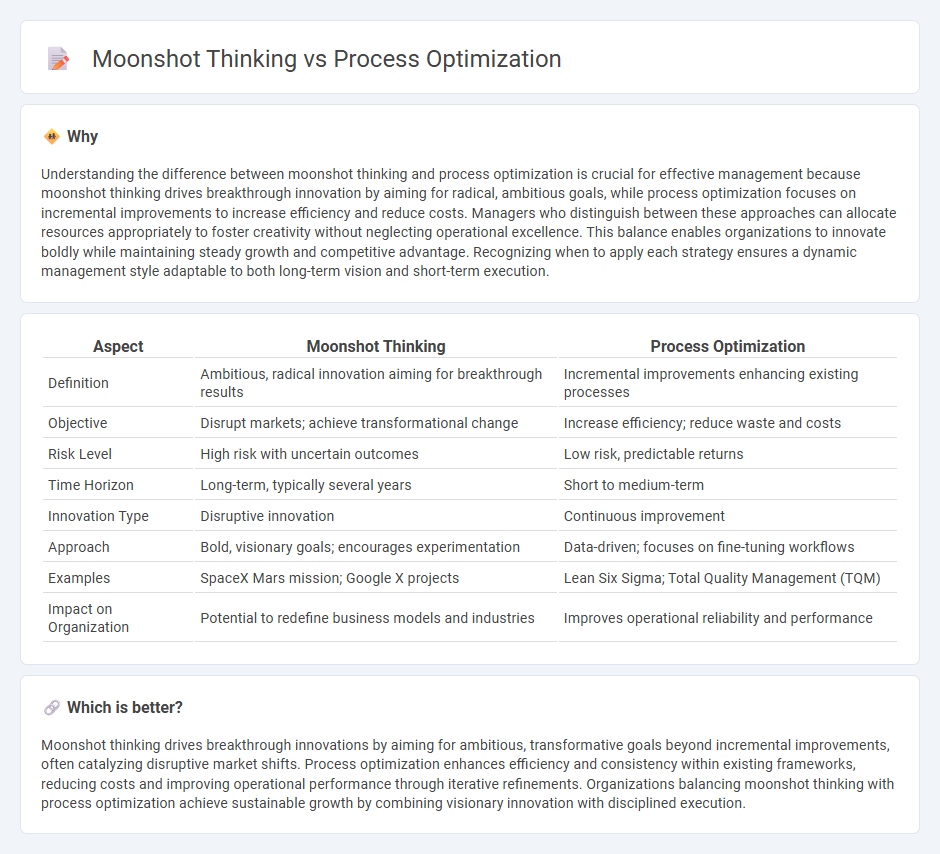
Moonshot thinking drives radical innovation by aiming for breakthrough goals that redefine industries, while process optimization focuses on enhancing existing workflows for efficiency and incremental improvements. Organizations balancing visionary aspirations with streamlined operations achieve sustainable growth and competitive advantage. Explore how integrating moonshot thinking with process optimization transforms management strategies.
Why it is important
Understanding the difference between moonshot thinking and process optimization is crucial for effective management because moonshot thinking drives breakthrough innovation by aiming for radical, ambitious goals, while process optimization focuses on incremental improvements to increase efficiency and reduce costs. Managers who distinguish between these approaches can allocate resources appropriately to foster creativity without neglecting operational excellence. This balance enables organizations to innovate boldly while maintaining steady growth and competitive advantage. Recognizing when to apply each strategy ensures a dynamic management style adaptable to both long-term vision and short-term execution.
Comparison Table
| Aspect | Moonshot Thinking | Process Optimization |
|---|---|---|
| Definition | Ambitious, radical innovation aiming for breakthrough results | Incremental improvements enhancing existing processes |
| Objective | Disrupt markets; achieve transformational change | Increase efficiency; reduce waste and costs |
| Risk Level | High risk with uncertain outcomes | Low risk, predictable returns |
| Time Horizon | Long-term, typically several years | Short to medium-term |
| Innovation Type | Disruptive innovation | Continuous improvement |
| Approach | Bold, visionary goals; encourages experimentation | Data-driven; focuses on fine-tuning workflows |
| Examples | SpaceX Mars mission; Google X projects | Lean Six Sigma; Total Quality Management (TQM) |
| Impact on Organization | Potential to redefine business models and industries | Improves operational reliability and performance |
Which is better?
Moonshot thinking drives breakthrough innovations by aiming for ambitious, transformative goals beyond incremental improvements, often catalyzing disruptive market shifts. Process optimization enhances efficiency and consistency within existing frameworks, reducing costs and improving operational performance through iterative refinements. Organizations balancing moonshot thinking with process optimization achieve sustainable growth by combining visionary innovation with disciplined execution.
Connection
Moonshot thinking drives radical innovation by setting ambitious goals that challenge conventional limits, while process optimization ensures the efficient use of resources to achieve these breakthrough objectives. Integrating moonshot thinking with continuous process improvement enables organizations to systematically overcome barriers and accelerate transformational change. This synergy enhances strategic management by aligning visionary ideas with practical execution methods, maximizing impact and sustainability.
Key Terms
**Process Optimization:**
Process optimization involves refining existing workflows and systems to enhance efficiency, reduce costs, and improve quality using data-driven techniques like Lean Six Sigma and continuous improvement methodologies. It emphasizes incremental changes that maximize operational performance within current frameworks and resources. Discover how process optimization can revolutionize your business outcomes with targeted improvements.
Efficiency
Process optimization targets incremental efficiency improvements by refining existing workflows, reducing waste, and enhancing resource utilization to boost productivity. Moonshot thinking aims for breakthrough innovation with bold, radical goals that can disrupt industries but often involves higher risk and uncertainty. Explore how combining these approaches can transform your operational strategy and drive sustained success.
Continuous Improvement
Process optimization emphasizes incremental improvements to streamline workflows, reduce waste, and enhance efficiency in operational tasks. Moonshot thinking targets radical innovation by pursuing breakthrough ideas that can redefine industries, often involving high risk and uncertainty. Explore how continuous improvement strategies balance steady progress while fostering transformative potential for long-term success.
Source and External Links
Process Optimization Methods: Definition, Benefits and Types - Process optimization involves structured methods like PDSA, DMAIC, and process mining to improve quality, efficiency, and performance by analyzing and refining business workflows.
Process optimization - Wikipedia - Process optimization is the discipline of adjusting a process to maximize parameters such as efficiency and throughput while minimizing costs and respecting constraints, often through equipment, procedure, and control enhancements.
What is process optimization? | IBM - Process optimization uses structured methods and technologies, including automation and AI, to remove inefficiencies, increase quality, and support continuous improvement in business operations.
 dowidth.com
dowidth.com